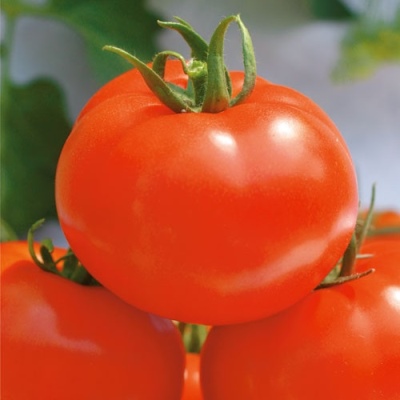
- Authors: Chulkov N.I., Popova L.N., Arinina L.P., Popov V.I.
- Year of approval: 1989
- Category: grade
- Growth type: determinant
- Appointment: fresh consumption, for pickling and canning, for whole-fruit canning
- Ripening period: mid-season
- Ripening time, days: 105-115
- Growing conditions: for open ground
- Marketability: high
- Transportability: high
When choosing a variety of tomatoes for growing on a personal plot, it is recommended to give preference to species that are unpretentious in care and give abundant yields. One of these is the mid-early variety Volgogradets.
Breeding history of the variety
The Volgogradets tomato is a variety that was the result of the work of a group of domestic breeders (Chulkov, Popova, Arinina, Popov), recommended for cultivation in the Central Black Earth Region, the Urals and the Far East. Included in the state register in 1989.
Description of the variety
The Volgogradets culture is a low shrub with a determinant type of growth, which stretches up to 60-70 cm in height. The plant is characterized by semi-spreading branches, strong thick foliage of light green color, simple inflorescence and weak root system. The variety is ideal for outdoor cultivation. It is massively grown on an industrial scale and harvested once a season using a mechanized method.
The main qualities of the fruit
The Volgogradets tomato is of medium size - the weight of the berry is 58-79 grams and a uniform red color. The tomato is rounded in shape with barely noticeable ribbing. The peel of fully ripe tomatoes is quite dense, has a glossy finish, does not spoil the taste of the fruit at all.
The advantage of tomatoes is their universal purpose - they are eaten fresh, as well as canned (especially whole-fruit roll), processed. The keeping quality of fruits is weak - about 10-14 days under normal conditions, however, the preservation during transportation is high.
Taste characteristics
Volgogradets tomato is fragrant and tasty. The pulp of the fruit is juicy and fleshy. The dry matter content in the juice is 4-5%, and the total sugar content is 3.7%. Tomatoes have a pronounced taste with dominant sweetness.
Ripening and fruiting
Mid-season variety. It takes 105-115 days for the first tomatoes to fully ripen. Uniform ripening of fruits is characteristic of the variety. The active fruiting phase begins from early July to late August. In greenhouses in the northern regions of growth, the timing of ripening and fruiting is somewhat shifted.
Yield
The yield of the species is quite high. Observing all the rules of agricultural technology, it is possible to harvest a good harvest from 1 m2 - 5-8 kg of tomatoes. On an industrial scale, about 500-801 centners per hectare are collected.
The timing of planting seedlings and planting in the ground
Seeds are sown for seedlings in March. This will require purchased soil and pots. After sowing, you need to provide a greenhouse effect to the seeds in order to accelerate their germination. In addition, for normal growth, you will need warmth in the room and adequate lighting (14-16 hours a day). A pick (seating in separate containers) is carried out when 2-3 true leaves appear on the bush.3-4 weeks before planting in the ground, it is recommended to daily harden the sprouts in the fresh air, taking them out for 15-20 minutes.
Planting in the ground or greenhouse is carried out in May / June. The soil should be warmed up, and night frosts should be left behind. The optimal soil for growing tomatoes of the Volgogradets variety is considered to be the one where greens, onions or garlic previously grew. You need to transplant seedlings on a cloudy day.

Growing tomato seedlings is an extremely important process, because it largely depends on whether the gardener will be able to harvest at all. All aspects must be taken into account, from seedbed preparation to planting in the ground.
Landing scheme
The optimal planting scheme is 70x60 cm. At the same time, it is recommended to plant no more than 3 bushes of seedlings per square meter. In the greenhouse, you need to plant the bushes in a checkerboard pattern, which will create the most convenient conditions for caring for the crop.

Growing and care
The tomato is grown in seedlings. For healthy crop growth, it is worth choosing a site with dug up soil that breathes, is sufficiently fertilized with mineral and organic components, and is also free of grass and weeds. Care should be comprehensive - watering, feeding, loosening the soil, regular pinching, garter to supports, prevention of infections.




A plant needs different micronutrients at each stage of growth. All fertilizers can be divided into two groups: mineral and organic. Folk remedies are often used: iodine, yeast, bird droppings, eggshells.
It is important to observe the rate and period of feeding. This also applies to folk remedies and organic fertilizers.
Disease and pest resistance
The tomato has a weak immunity, especially to the tobacco mosaic virus, late blight and apical rot, so you will have to protect tomatoes from various pests and diseases. Treatment with special preparations, which are forbidden to be carried out a month before harvest, will help to fight bacteria.


Resistant to adverse weather conditions
Resistance to weather anomalies and temperature extremes is present in this species, therefore it grows well both in the southern regions and in the northern ones.
Growing regions
The variety is massively grown throughout Russia, Ukraine and Belarus.
Review overview
Volgogradets tomatoes can often be found in summer cottages, as well as in farmlands, since they quickly adapt to the soil, give rather high yields, are well transported without losing their presentation, and also have high taste. Of the shortcomings, only a weak immunity to diseases is indicated.

























































































